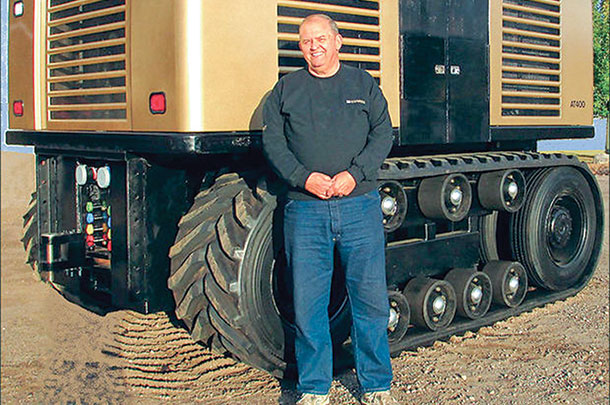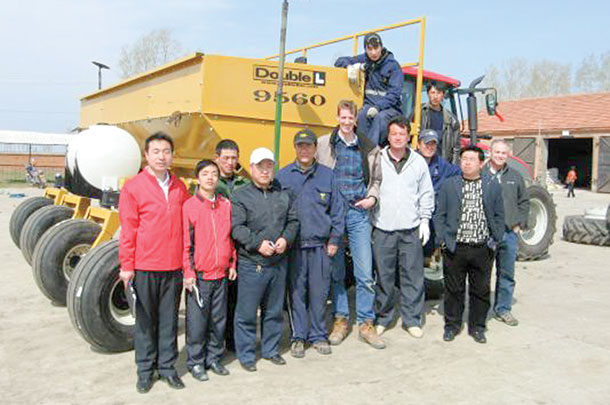Over the years, he has helped create some tools that make life easier for farmers, including a stroke counter for hay balers, a shaft rotation monitor, a drip irrigation tool to measure condensation and a farm alarm that measures humidity for baling hay.
“If someone thinks they need it, we find a way to build it,” Haslam says.
He said he is a self-taught mechanical engineer who didn’t grow up on a farm but enjoys working in the farm arena.
“I’ve been building electronics since I was knee-high to a grasshopper,” he says. “It’s my life; it’s what keeps me going – I really enjoy what I do.”
Maurice Theriault insists that he isn’t any big deal.
“I am lazy,” he says. “I am just going to sit there and think until I can figure out a better way to do things.”
Theriault was trained as a carpenter but then took some drafting classes, and since he was already mechanically inclined, it all just came together for him.
He was working on equipment that pulls irrigation hoses out of carrot fields. The original equipment took 10 to 12 people in each crew, and his employer had several crews. It would lift the irrigation pipe out of the field, dismantle it in 20-foot segments and then roll the pipe onto a trailer.
The problem was that it took too many people and too much time. With Theriault’s adjustment, the pipes can now be pulled from the field in half-mile segments as it pulls each segment apart.
“You don’t want tractors in carrot fields,” Theriault says. “Once a tractor goes into a field, it compacts the soil, and the carrots don’t like it. This way the carrots are looser, fewer carrots stay in the ground, and you get a greater yield.”
The best part is that it only takes a crew of five people to pull all of the pipe out of a field. His innovation saves both time and money.
Richard Wallace is another man who spends a lot of time playing with machinery, but his specialty has been potato equipment while working with Double L in Heyburn, Idaho.
“I have always loved all things mechanical,” Wallace says. “I grew up working on cars and inventing things. It’s in my DNA, so mechanical engineering was a natural fit for me – I like inventing things.”
He was hired right out of college by Double L so has been with them a significant amount of time – enough to have had a hand in almost all of their equipment, which is saying quite a bit as they handle anything having to do with potatoes, from planting to harvesting.
“From an engineering perspective, there is a lot of hands-on, out-in-the-field type of work, especially during harvest, watching the equipment,” Wallace says. “I spend a fair amount of time behind a computer screen, but I really enjoy the part of my job where I am literally standing out in a field – where I can kick the dirt and get my hands greasy.”
He said that Double L has been expanding their market outside the U.S. and, as a result, he has had the opportunity to travel quite a bit, especially to China, where he speaks the language.
“In the U. S., potato equipment evolved fast and got bigger and bigger so that it is mostly limited now by road size,” Wallace says. “Overseas, they have skipped all of the steps we went through, and when they open the box now, it is like someone seeing the space shuttle for the first time.”
Wallace says that the newer potato equipment is almost mind-blowing to people who are used to using a shovel in a field or crude equipment at best.
“It is very fulfilling to see how life-changing our equipment can be,” he says. “As a company, we have put a pin in the map all over the world except, perhaps, Africa. It’s fun seeing our equipment in a new light.”

Terry Anderson is 73 years young and currently working on his 13th company. For many, the number 13 would be offsetting but to Anderson, it isn’t.
“I’ve been dumb enough to decide that I can start businesses and make a go of them,” Anderson says. “I love challenges.”
Years ago, while working for a company, he came across another company with a problem he figured he could solve. The thing was, the company he was working for didn’t want to resolve the problem, so Anderson asked if he could take the project on, and he did – at night and on his own time. Eventually, he solved the problem, and the company loved the results, so they offered him a job.
“I thought about it and then decided to start my own company,” Anderson says. “Each time I solve a problem, I learn something and I build another company, and I find another market for my innovations.”
Company No. 7 sold for $1.8 billion, and for a time he tried retirement but found it boring, so he went to Automation Research in 1999. By 2004, he realized that agriculture was at least 80 years behind the technology available.
“The diesel engine was developed in 1920, and there hadn’t been any serious advancement in the 80 years since then,” he says. “I knew three technologies that could cut costs by 75 percent. I grew up on a farm, and when I saw the problems farmers were having, I knew I could do something about it.”
One of the things he has done is to take robotics and apply it to farming with the invention of autonomous tractors.
“One of the hardest things for a farmer is finding good employees,” he says. “With our tractors, you can cut labor costs by 75 percent – besides which, the tractor lasts longer with a fraction of the repair costs.”
One of his latest companies is creating a way to use anhydrous ammonia fuel cells to create fertilizer and fuel for farmers. He branched out in this direction after investigating what people in England did during World War II.
Initially, he thought they used horses for farm work, but then he discovered that they were using ammonia to fuel their vehicles. It made sense to him, as it is cheaper and easier to come by. He calls this company the Rural Energy Corporation.
Anderson says that he enjoys doing what he does and he likes working with the people he works with now. He also echoes the sentiment that Theriault expressed when finding new solutions to older problems: In order to find a different solution, you must think entirely differently than the brain that created the problem.
“I like to work with people who like to work outside the box – the further outside, the better,” he says. “Everyone agrees with me, but no one else has the guts to do it.” FG
Becky Cook is a freelance writer based in Idaho.
PHOTO 1: Richard Wallace, the tall man in the middle, stands in front of a new six-row potato planter recently delivered to the Heilungjyang Province and set up on a farm north of BeiAn. The other men in the picture are farm employees and technicians from the Chinese dealership that sold the planter.
Wallace flew to China to help assemble the planter as it came out of the shipping container and then provided operational training to the farm employees. Photo courtesy of Double L.
PHOTO 2: Terry Anderson, inventor and innovator, poses in front of one of his latest inventions – a totally autonomous tractor. Anderson has developed many useful innovations during his lifetime, many of which will change the way farmers farm their ground in the years to come. Photo courtesy of Autonomous Tractor Company.













